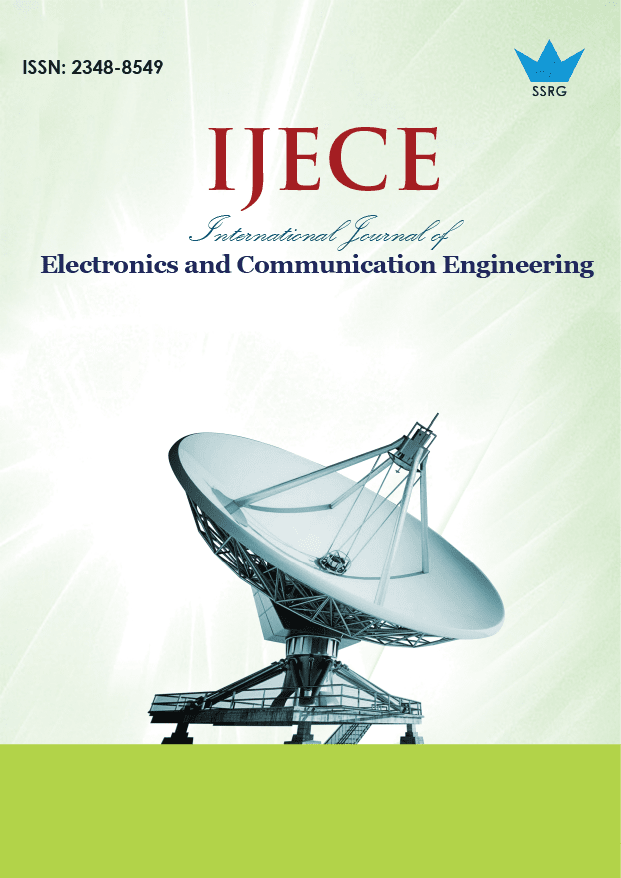Spectrum Sensing in Cognitive Radio Using Multiple Antenna by Eliminating Phase Noise

| International Journal of Electronics and Communication Engineering |
| © 2025 by SSRG - IJECE Journal |
| Volume 12 Issue 8 |
| Year of Publication : 2025 |
| Authors : Mahesh Kumar N, Arthi R |
How to Cite?
Mahesh Kumar N, Arthi R, "Spectrum Sensing in Cognitive Radio Using Multiple Antenna by Eliminating Phase Noise," SSRG International Journal of Electronics and Communication Engineering, vol. 12, no. 8, pp. 149-160, 2025. Crossref, https://doi.org/10.14445/23488549/IJECE-V12I8P113
Abstract:
Efficient spectrum sensing is crucial in Cognitive Radio Networks (CRNs) to identify and utilize unoccupied frequency bands, unobtrusively for primary users. By providing spatial diversity, the use of multiple antennas can enhance spectrum sensing performance. The proposed work makes use of multiple antenna spectrum sensing with a Deep Q Network (DQN) model to ascertain the existence of an estimated signal. The presence of phase noise reduces the efficiency of spectrum sensing compared to other widely used methods. To overcome this, the proposed work adopts Jelly Fish Optimization (JFO), Single Candidate Optimization (SCO) and Sand cat swarm optimization algorithms with Multiple Antenna Spectrum Sensing DQN (MASSDQN) to decrease the phase noise and enhance the spectrum sensing. The experimental outcome demonstrates the superior performance of the sand cat swarm optimization technique in multiple antenna spectrum sensing and optimize the phase noise for the secondary users to harness the spectrum effectively.
Keywords:
MASSDQN, Spectrum Sensing, Phase Noise, Cognitive Radio Network, Single Candidate Swarm Optimization.
References:
[1] Luxin Zhang et al., “MASSnet: Deep Learning-Based Multiple-Antenna Spectrum Sensing for Cognitive Radio-Enabled Internet of Things,” IEEE Internet of Things Journal, vol. 11, no. 8, pp. 14435-14448, 2024.
[CrossRef] [Google Scholar] [Publisher Link]
[2] Xinzhi Zhang et al., “Matched Filter based Spectrum Sensing when Primary User has Multiple Power Levels,” China Communications, vol. 12, no. 2, pp. 21-31, 2015.
[CrossRef] [Google Scholar] [Publisher Link]
[3] Zahra Pourgharehkhan, Abbas Taherpour, and Saeed Gazor, “Spectrum Sensing Using a Uniform Uncalibrated Linear Antenna Array for Cognitive Radios,” IEEE Transactions on Wireless Communications, vol. 18, no. 2, pp. 741-752, 2019.
[CrossRef] [Google Scholar] [Publisher Link]
[4] Lucas dos Santos Costa, Fátima Sayury Queralt Queda Alves, and Rausley Adriano Amaral de Souza, “Multiantenna-Cognitive-Radio-Based Blind Spectrum Sensing under Correlated Signals and Unequal Signal and Noise Powers,” Electronics, vol. 11, no. 11, pp. 1-19, 2022.
[CrossRef] [Google Scholar] [Publisher Link]
[5] Jiandong Xie et al., “Unsupervised Deep Spectrum Sensing: A Variational Auto-Encoder based Approach,” IEEE Transactions on Vehicular Technology, vol. 69, no. 5, pp. 5307-5319, 2020.
[CrossRef] [Google Scholar] [Publisher Link]
[6] Danyang Wang et al., “Multiple High-Order Cumulants-based Spectrum Sensing In Full-Duplex-Enabled Cognitive IoT Networks,” IEEE Internet of Things Journal, vol. 8, no. 11, pp. 9330-9343, 2021.
[CrossRef] [Google Scholar] [Publisher Link]
[7] An-Zhi Chen, and Zhi-Ping Shi, “Covariance-Based Spectrum Sensing for Noncircular Signal in Cognitive Radio Networks with Uncalibrated Multiple Antennas,” IEEE Wireless Communications Letters, vol. 9, no. 5, pp. 662-665, 2020.
[CrossRef] [Google Scholar] [Publisher Link]
[8] Keunhong Chae, and Yusung Kim, “DS2MA: A Deep Learning-based Spectrum Sensing Scheme for a Multi-Antenna Receiver,” IEEE Wireless Communications Letters, vol. 12, no. 6, pp. 952-956, 2023.
[CrossRef] [Google Scholar] [Publisher Link]
[9] Roberto López-Valcarce, Gonzalo Vazquez-Vilar, and Josep Sala, “Multiantenna Spectrum Sensing for Cognitive Radio: Overcoming Noise Uncertainty,” 2010 2nd International Workshop on Cognitive Information Processing, Elba, Italy, pp. 310-315, 2010.
[CrossRef] [Google Scholar] [Publisher Link]
[10] David Ramirez et al., “Detection of Rank-P Signals in Cognitive Radio Networks with Uncalibrated Multiple Antennas,” IEEE Transactions on Signal Processing, vol. 59, no. 8, pp. 3764-3774, 2011.
[CrossRef] [Google Scholar] [Publisher Link]
[11] Abbas Taherpour, and Mohammadreza Toghraei, “A Universal Multiple Antenna Test for Spectrum Sensing,” IEEE Communications Letters, vol. 23, no. 2, pp. 326-329, 2019.
[CrossRef] [Google Scholar] [Publisher Link]
[12] Mohammad Reza Khanzadi, Phase Noise in Communication Systems: Modeling, Compensation, and Performance Analysis, Chalmers University of Technology, pp. 1-44, 2015.
[Google Scholar] [Publisher Link]
[13] M. Reza Khanzadi, Rajet Krishnan, and Thomas Eriksson, “Estimation of Phase Noise in Oscillators with Colored Noise Sources,” IEEE Communications Letters, vol. 17, no. 11, pp. 2160-2163, 2013.
[CrossRef] [Google Scholar] [Publisher Link]
[14] Rajet Krishnan et al., “Linear Massive MIMO Precoders in the Presence of Phase Noise - A Large-Scale Analysis,” IEEE Transactions on Vehicular Technology, vol. 65, no. 5, pp. 3057-3071, 2015.
[CrossRef] [Google Scholar] [Publisher Link]
[15] J. Dauwels, and H.A. Loeliger, “Phase Estimation by Message Passing,” 2004 IEEE International Conference on Communications, Paris, France, vol. 1, pp. 523-527, 2004.
[CrossRef] [Google Scholar] [Publisher Link]
[16] G. Colavolpe, A. Barbieri, and G. Caire, “Algorithms for Iterative Decoding in the Presence of Strong Phase Noise,” IEEE Journal on Selected Areas in Communications, vol. 23, no. 9, pp. 1748-1757, 2005.
[CrossRef] [Google Scholar] [Publisher Link]
[17] Lucas dos Santos Costa et al., “Performance of Blind Cooperative Spectrum Sensing under Nonuniform Signal and Noise Powers,” Journal of Communication and Information Systems, vol. 33, no. 1, pp. 158-171, 2018.
[CrossRef] [Google Scholar] [Publisher Link]
[18] Hongwei Ge et al., “Cooperative Deep Q-Learning with Q-Value Transfer for Multi-Intersection Signal Control,” IEEE Access, vol. 7, pp. 40797-40809, 2019.
[CrossRef] [Google Scholar] [Publisher Link]
[19] Chong Huang et al., “Joint Buffer-Aided Hybrid-Duplex Relay Selection and Power Allocation for Secure Cognitive Networks with Double Deep Q-Network,” IEEE Transactions on Cognitive Communications and Networking, vol. 7, no. 3, pp. 834-844, 2021.
[CrossRef] [Google Scholar] [Publisher Link]
[20] Amjad Iqbal, Mau-Luen Tham, and Yoong Choon Chang, “Double Deep Q-Network-Based Energy-Efficient Resource Allocation in Cloud Radio Access Network,” IEEE Access, vol. 9, pp. 20440-20449, 2021.
[CrossRef] [Google Scholar] [Publisher Link]

 10.14445/23488549/IJECE-V12I8P113
10.14445/23488549/IJECE-V12I8P113